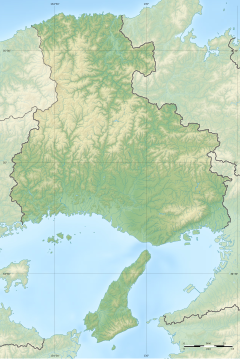Inano Shrine (猪名野神社, Inano jinja) is a Shinto shrine located in the Miyamae neighborhood of the city of Itami, Hyogo Prefecture, Japan. The shrine grounds are designated as a national historic site as part of the ruins of Sengoku period Itami Castle.[1][2]
| Inano Shrine 猪名野神社 | |
|---|---|
 | |
| Religion | |
| Affiliation | Shinto |
| Deity | Inanoza Ōkami Susanoo |
| Festival | April 23, June 30, July 16, October 13-14 |
| Location | |
| Location | Miyanomae, Itami-shi, Hyōgo-ken |
| Geographic coordinates | 34°47′07″N 135°24′55″E / 34.78528°N 135.41528°E |
| Architecture | |
| Style | Kasuga-zukuri |
| Date established | c.645–654 |
History
editAccording to legend, the shrine was built in Inadera (currently Inadera, Amagasaki) during the time of Emperor Kōtoku (645–654, during the Asuka period) and was relocated to the present location in 904. In ancient times, the shrine was called "Nonomiya", "Tennomiya", "Ushito Tennomiya", and other names.[3] In 1574, Araki Murashige rebuilt Itami Castle as a Sogamae (総構え) type of fortification in which the entire castle town forms part of the defenses by being completely encircled by moats and earthen ramparts, and with the arrangement of streets and townhouses planned as part of the defensive belt. Inano Shrine fell within the northernmost fortress of the outer defenses, and a bastion, the Kishi-no-toride (岸の砦) was constructed on the location of the shrine. It was destroyed by the forces of Oda Nobunaga in Siege of Itami (1579). In 1661, the Itami area became the territory of the Konoe family, and in 1685 Konoe Motohiro rebuilt the shrine.The current Honden of the shrine was completed in 1686.
Due to the shinbutsu bunri policy (separation of Shinto and Buddhism) in 1869, Kannon-do, Jizo-do and Buddhist-related records were moved to Kōngo-in, and the name of the shrine was changed from Nonomiya to its present name, Inano Shrine.[4] The shrine was ranked as a Prefectural Shrine in modern system of ranked Shinto Shrines. As such it follows the tradition of the Gion faith.
There are 98 stone lanterns donated by sake brewers and merchants on the shrine grounds. The oldest one was made in 1643, and the guardian dog pedestal was built in 1768.[5]
See also
editExternal links
editMedia related to Inano-jinja at Wikimedia Commons
Notes
edit- ^ 日本の歴史地名大系第二十九巻I 兵庫県の地名. Japan: Heibonsha. 1999. p. 406.
- ^ "伊丹城跡". Cultural Heritage Online (in Japanese). Agency for Cultural Affairs. Retrieved 15 September 2021.
- ^ 伊丹市史 (Itami City History). Vol. 3. Japan: Itami City. 1972. p. 135.
- ^ 伊丹の文化財. Japan: Itami City Board of Education. 1995. p. 75.
- ^ 新・伊丹史話. Japan: Itami City Museum. 1994. p. 299.


